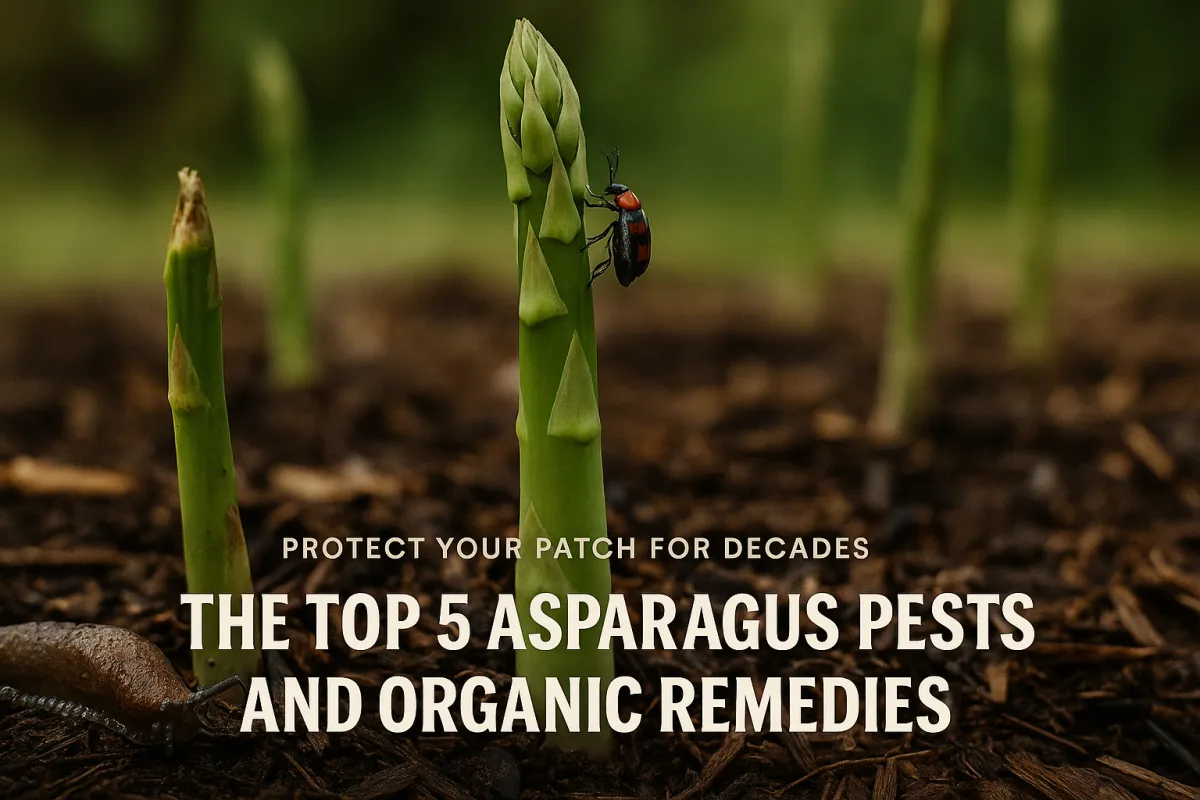
The Top 5 Asparagus Pests and Organic Remedies
Lessons From the First Spears
The first time I grew asparagus, I thought I had it made. After all, this wasn’t lettuce or radishes that come and go in a season—this was a perennial, a long-term investment. I still remember the excitement of those first tender spears poking through in spring. But the excitement turned quick when I noticed beetles chewing on the shoots and slime trails left by slugs. In just a few days, what was supposed to be my first harvest looked battered.
That was a wake-up call. Asparagus is one of those crops that will reward you for years—if you protect it. Ignore the pests, and they’ll strip the bed bare, year after year. Here are the top five culprits you’ll run into and the organic remedies that actually work.
Why Pest Control Matters for Asparagus Beds
An asparagus crown can produce for 15–20 years if cared for well. That means every pest problem isn’t just this season’s frustration—it’s a threat to the next decade of harvests.
Where you live matters too. In Northern zones (4–6), you might only battle one or two pest cycles a season, but you’ll fight deer and rabbits harder. In Southern zones (7–9), insect pests cycle faster and pressure stays higher throughout the year.
Either way, the principle is simple: protect the patch early, and it will feed you for decades.
1. Asparagus Beetles (Common & Spotted)
Identification
Common asparagus beetle: blue-black with red margins.
Spotted asparagus beetle: reddish-orange with black spots.
Both lay eggs on spears; larvae feed on ferns.
Damage
Brown eggs line spears like tiny grains of rice.
Chewed ferns reduce photosynthesis, weakening crowns for future harvests.
Organic Remedies
Hand-pick daily — knock beetles into a jar of soapy water.
Neem oil or insecticidal soap — use sparingly on ferns.
Encourage predators — ladybugs and lacewings thrive if you give them a place to stay.
Grandma’s Tip: “If you see little brown eggs lined up on your spears, knock them off quick—don’t wait a day.”
2. Cutworms on Young Shoots
Identification & Damage
Plump gray-brown caterpillars hiding in soil or mulch.
Feed at night, severing young shoots at soil level.
Organic Remedies
Cardboard or tin-foil collars around young spears.
Evening flashlight patrols — pluck them off before they feed.
Diatomaceous earth sprinkled around crowns to discourage climbing.
Pro Tip: Always check under mulch—cutworms hide right at the soil surface. Pull back mulch and you’ll find them curled tight in the debris.
3. Aphids on Ferns
Identification
Tiny green or black insects clustered on fern undersides.
Damage
Curling, yellowing ferns → weakened crowns.
Ants often appear too, farming them for honeydew.
Organic Remedies
Blast with water — a strong hose jet knocks most off.
Encourage ladybugs/lacewings — they’ll clear colonies fast.
Neem or insecticidal soap if infestations keep coming back.
4. Slugs & Snails in Damp Beds
Identification & Damage
Ragged holes in spears and ferns.
Shiny slime trails on soil and plants.
Organic Remedies
Beer traps — bury shallow dishes of beer; slugs crawl in and drown.
Iron phosphate baits — safe around edibles, works quickly.
Copper tape or barriers — creates a mild shock that keeps them away.
Reduce damp mulch — don’t give them cover.
5. Deer & Rabbits Nibbling Spears
Identification & Damage
Rabbits: angled bites, spears cut like a pencil sharpener.
Deer: whole shoots missing overnight, ferns stripped.
Organic Remedies
Fencing — 2–3 ft wire for rabbits; 6–8 ft for deer.
Motion-activated sprinklers — a shock of water sends them running.
Repellent sprays — garlic or blood meal-based, safe for the bed.
Region-Specific Notes
North (Zone 4–6): Deer and rabbits are your constant enemy. Keep fencing ready.
South (Zone 7–9): Insects cycle fast. Expect two or three beetle generations—stay ahead with regular scouting.
Printable Tool / Lead Magnet
👉 Download the “Asparagus Pest ID & Remedy Quick-Chart” — a one-page printable with photos and organic controls you can pin in your garden shed.
Faith Alignment
Asparagus takes patience—years of waiting before the first real harvest, and steady guarding after that. The same is true in life. “Let us not grow weary while doing good, for in due season we shall reap if we do not lose heart” (Galatians 6:9). Guard what’s been entrusted to you, and the harvest will come.
Closing: Guard the Patch, Enjoy the Harvest
Your asparagus bed is one of the best long-term investments on the homestead. Don’t let pests steal it from you. Check your spears regularly, use these organic remedies, and your patch will reward you with decades of faithful harvests.
Download the pest chart, walk your rows this week, and share what’s been working for you—I’d like to hear how you’re keeping your asparagus strong.


Facebook
Instagram
X
Youtube